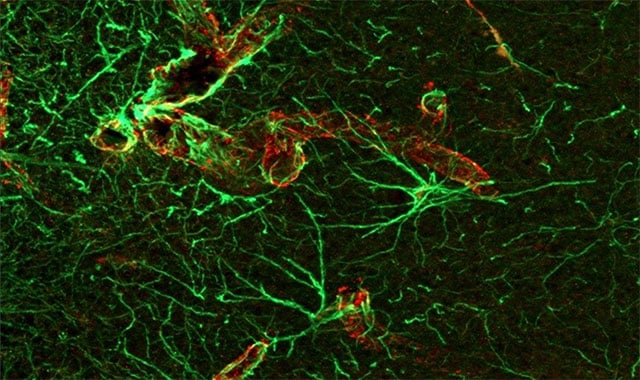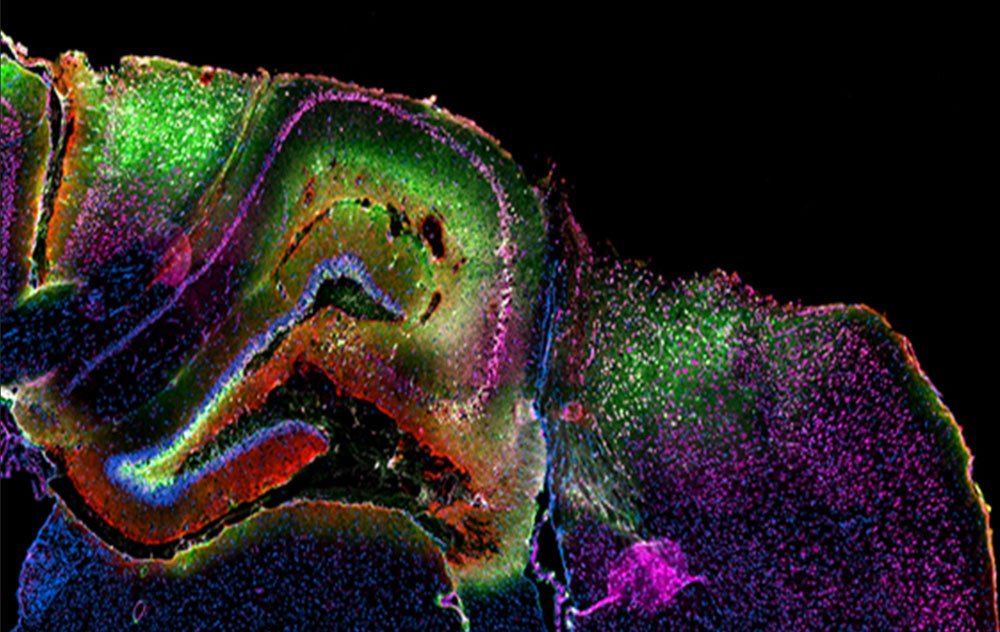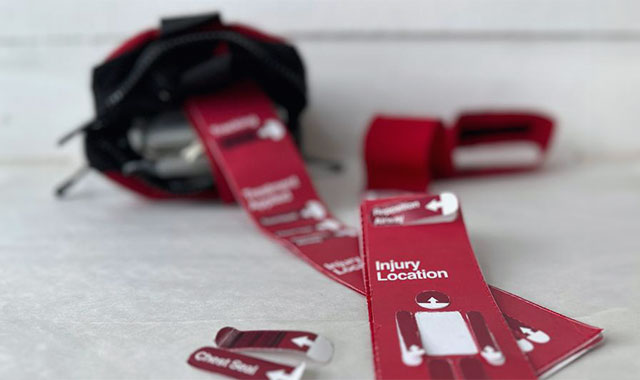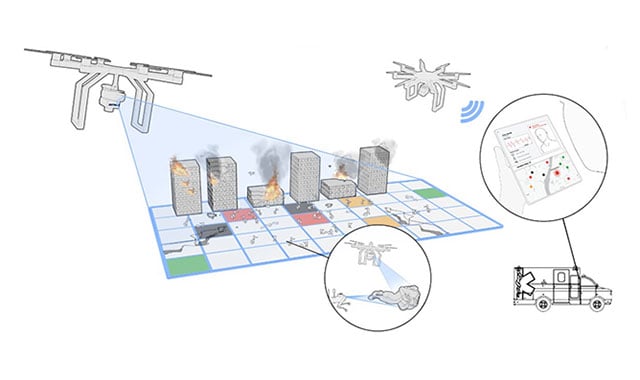Stopping Brain Injury Before It Starts

Figure 1. Example of inflammation in a ferret brain through visualization of astrocytes using antibodies to label GFAP (glial fibrillary acidic protein; green) and the end feet of the astrocytes that surround blood vessels, visualized using antibodies to label aquaporin 4 (red), a water channel protein. Image provided by the Juliano lab at USU.
Battelle received a five-year, $22 million contract through Defense Advanced Research Projects Agency’s Cornerstone program to create a preventative medical intervention to stop traumatic brain injury.
Traumatic brain injury (TBI) is a significant concern for U.S. warfighters, whether in training accidents or combat environments. A vehicle crash, proximity to an explosion or another event resulting in a jolt to the head could result in a mild to severe TBI. These injuries can result in long-term effects, including memory problems, sleep disorders, slower thinking, irritability and depression. Exposure to repeated head trauma, which is common in military environments, increases the risk of neurodegenerative diseases.
The Defense Advanced Research Projects Agency (DARPA) established the Cornerstone program to create preventative methods that target the initial response to a TBI, reducing the treatment needed following a brain injury. Battelle received a five-year, $22 million contract to develop a prophylactic medical intervention through the DARPA Cornerstone program.
Today, most preventative measures involve helmets and vehicle armor to avoid a direct blow to the head or stop an explosive shockwave. Treatment after an injury involves an extensive combination of physical and psychological rehabilitation, often with limited success. At the moment an injury occurs to the brain, a complex series of cellular and molecular events is triggered in the body (Figure 1). This initiates a domino effect over the course of weeks or even months that amplifies the damage in the brain, requiring extensive rehabilitation treatment.
The novel prophylactic concept is for military service members to receive a countermeasure in advance of entering an environment in which they are at high risk for receiving a TBI.
“The therapeutic would be administered prior to a warfighter entering a blast-intensive environment,” said Rachel Spurbeck, Senior Genomics Research Scientist, who is the Principal Investigator of the Cornerstone program, “The therapeutic, which binds to early markers of trauma, could stop the downstream cascading effects before they start, thereby preventing injury.”
For early-stage prototypes, the team plans to use intravenous injection to deliver the preventative countermeasure. They are also considering nasal spray as an administration method in future development phases.
The Battelle Team consists of investigators from five institutions: Battelle, University of California San Diego (UCSD), AivoCode, Uniformed Services University (USU), and the University of Tartu, who are all dedicated to the study, prevention, and treatment of TBI enabled by nanomedicine delivery systems that incorporate small peptides as the functional units. Dr. Tambet Teesalu from the University of Tartu will identify therapeutic peptides through an in vivo phage display, AivoCode will characterize prophylactic candidates starting with a lead peptide that has already been identified. Battelle will supplement therapeutic peptide discovery through evolutionary biology-inspired algorithms to guide structure-based design and lead optimization. Professors Michael Sailor and Ester Kwon from UCSD will provide active targeted nanoparticle delivery systems and in vitro blast model testing. Augmenting this effort, Battelle will utilize its high-throughput discovery platform to develop passively targeted polymer nanoparticle (PNP) delivery systems. Professors Sharon Juliano and Joseph McCabe from USU will test the prophylactic efficacy and safety of the resulting systems using the Advanced Blast Simulator, which replicates the type of blast-induced shock waves commonly encountered in the field.

Figure 2. Brain sections showing that nanomaterials modified with peptides that bind to the extracellular matrix (green) are present in the injured brain when they were delivered via the blood in a mouse model of traumatic brain injury. Image provided by the Kwon lab at UCSD.
During the first phase of the program, Battelle’s team will focus on identifying and optimizing potential therapeutics and demonstrating that nanoparticles can target delivery to the appropriate organs. In future phases, they’ll create an integrated countermeasure combining the therapeutic with the nanoparticle delivery method (Figure 2), as well as begin the regulatory testing required for approval by the Food and Drug Administration. By the end of the five-year program, the team will downselect the top candidates and conduct preclinical testing, providing a potential preventative countermeasure that is ready for clinical trials.
This complex program relies on the team’s broad expertise, including materials science, biology, bioengineering, data analytics, bioinformatics and preclinical research.
“We’re leveraging the breadth of what Battelle offers,” said James Ha, Principal Scientist, who is the Program Manager. “Bringing capabilities together from the whole enterprise as well as a stellar team of collaborators helped us win the program. We are excited to focus their wide range of expertise on a problem of such critical importance to the wellbeing of our warfighters.”
Related Blogs
BATTELLE UPDATES
Receive updates from Battelle for an all-access pass to the incredible work of Battelle researchers.







